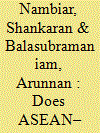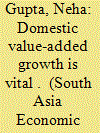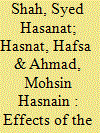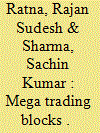|
|
|
Sort Order |
|
|
|
Items / Page
|
|
|
|
|
|
|
| Srl | Item |
| 1 |
ID:
147897


|
|
|
|
|
| Summary/Abstract |
This article aims to address the extent of income that has been attributed by trade between India and the ASEAN-5 countries (namely, Indonesia, Malaysia, the Philippines and Thailand) from the year 1970 till 2014. This study adopts the autoregressive distributed lag (ARDL) bound test approach to cointegration, with long- and short-run parameter estimates to investigate the impact of regional trade between India and ASEAN-5. The cointegration test results confirmed the presence of a long-run relationship only for India, and no cointegration evidence was found for the ASEAN-5 economies. The long-run parameter estimates showed no influence of ASEAN–India trade on India’s income and a positive impact of India’s trade to the rest of the world on India’s income by about 0.58 per cent in the long run. Interestingly, ASEAN–India trade is positively influencing India’s income in the short run, and the extent of the impact tends to be small. This article concludes that there is limited evidence to support the claim that ASEAN–India trade stimulates income for the case of India and ASEAN-5 countries.
|
|
|
|
|
|
|
|
|
|
|
|
|
|
|
|
| 2 |
ID:
147896


|
|
|
|
|
| Summary/Abstract |
Gains under the global value chains (GVCs) depend on how much of a country’s domestic value added (DVA) is passing onto other countries. However, India’s manufacturing sector is found to be hollowing out, that is, its DVA growth is declining. This article estimates the linkages of manufacturing sector into GVCs, focusing on machinery and textiles industries. It measures foreign value added in exports and gains under GVCs using intercountry input–output tables of OECD–WTO Trade in Value Added (TiVA) database (2015). TiVA shows a decline in India’s share of DVA exports in its gross exports. However, India has ‘net gains’ from linking into GVCs in the two industries as the ratio of forward linkages to backward linkages is greater than one. This indicates that value-added exports are greater than value-added imports. Thus, India has enough potential to compete with other countries in the upper ends of value chains in both its machinery and textiles industries.
|
|
|
|
|
|
|
|
|
|
|
|
|
|
|
|
| 3 |
ID:
147895


|
|
|
|
|
| Summary/Abstract |
This article estimates the effect of integration with global apparel value chain on performance of Bangladesh apparel firms. The study does it by estimating an augmented Cobb–Douglas production function. The findings show that both backward linkage with foreign suppliers of intermediate inputs and forward linkage with global retailers of apparels positively affect firms’ output and labour productivity. By contrast, backward linkages with local suppliers have adverse effects on firm performances. The findings imply that it is a firm’s integration with the global apparel value chain, not the conventional backward linkage with domestic suppliers, that defines success of Bangladesh apparel industry in a globalizing world.
|
|
|
|
|
|
|
|
|
|
|
|
|
|
|
|
| 4 |
ID:
147893


|
|
|
|
|
| Summary/Abstract |
The main focus of this article is to investigate the short- and long-run causal effects of human cost of terror on gross domestic product (GDP), private consumption and private investment in Pakistan by using autoregressive distributed lag techniques. The results confirm the long-run association between the human cost of terror, GDP, private consumption and private investment and suggest that the human cost of terror adversely affects GDP and private investment, and positively influences private consumption in the long run. Furthermore, the results in the study reveal that the human cost of terror negatively affect GDP and private investment and increases private consumption in the short run. The overall findings of the article suggest that the human cost of terror drags the economy down, discourages private investment and distorts the pattern of private consumption in Pakistan.
|
|
|
|
|
|
|
|
|
|
|
|
|
|
|
|
| 5 |
ID:
147892


|
|
|
|
|
| Summary/Abstract |
This study investigates the effect of electricity consumption on economic growth of four South Asian countries, namely, Pakistan, India, Bangladesh and Sri Lanka, by employing time series annual data from 1980 to 2010. Pedroni’s panel cointegration results confirm that there exists valid long-run relationship between electricity consumption and economic growth in South Asia. Results of random effects model suggest the positive and significant impact of electricity consumption on economic growth of South Asian countries. Robustness of the initial findings of positive and significant relationship is confirmed by four different sensitivity analyses. Results of panel Granger causality test confirm the unidirectional causal relationship runs from electricity consumption to economic growth. It is therefore recommended that the South Asian countries should consider the development initiative and low-cost mode to produce electricity to enhance economic growth in the region.
|
|
|
|
|
|
|
|
|
|
|
|
|
|
|
|
| 6 |
ID:
147894


|
|
|
|
|
| Summary/Abstract |
Using a sample of Sri Lankan microfinance institutions (MFIs), we investigate the impact of several governance mechanisms on MFI efficiency, expressed in terms of the latter’s dual objectives of financial sustainability and outreach. Results reveal that smaller and gender-diverse boards have a positive impact on financial efficiency. Results also show that MFIs in which the chief executive officer (CEO) chairs the board and a woman holds the CEO position are less efficient in terms of poverty outreach.
|
|
|
|
|
|
|
|
|
|
|
|
|
|
|
|
| 7 |
ID:
147891


|
|
|
|
|
| Summary/Abstract |
The plethora of Regional Trade Agreements, especially in Asia, has created a complex web of noodle bowl, which has made trade more difficult. Many countries of Asia are now trying to be part of mega-free trade agreements (FTAs). While Association of Southeast Asian Nations (ASEAN) is consolidating through ASEAN+1 initiative leading to Regional Cooperation and Economic Partnership (RCEP), no such effort has been initiated so far by the South Asian Association for Regional Cooperation (SAARC). This study thus examines the possible effects of regional integration between ASEAN and SAARC on various sectors, as well as on macro-economic and trade areas by using the Global Trade Analysis Project (GTAP) model and database. A scenario of a complete integration between ASEAN and SAARC is simulated using the GTAP model, where the tariffs between ASEAN and SAARC are eliminated on all items but maintained for other trading partners. This article suggests for, among others, consolidation of ASEAN and SAARC FTAs, which will have a greater welfare enhancement, though some sectors will require adjustments due to their sensitivities. The article recommends for a policy dialogue between ASEAN and SAARC as such a process can only be initiated through a political engagement. It also recommends that the developing countries shall eliminate their tariffs in 5 years and allow longer time frame for the LDCs.
|
|
|
|
|
|
|
|
|
|
|
|
|
|
|
|
|
|
|
|
|